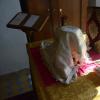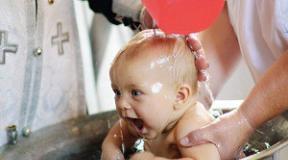Diagnosis of community-acquired pneumonia in children. Pneumonia in children. Community-acquired pneumonia
Community-acquired pneumonia (synonyms: home, outpatient) - acute infection lungs of various, mainly bacterial etiology, developed outside the hospital or in the first 48-72 hours of hospitalization, accompanied by symptoms of lower respiratory tract damage (fever, shortness of breath, cough and physical findings), in the presence of infiltrative changes on the radiograph. Therapy of community-acquired pneumonia in children is a topical issue in pediatrics. The morbidity and mortality from this disease remains quite high. A serious problem is timely diagnosis and adequate therapy for pneumonia on an outpatient basis, especially in children younger age... In recent years, new data on the etiology of pneumonia have appeared, which requires changes in approaches to the etiotropic therapy of the disease.
The development of pneumonia is associated with the penetration of microorganisms into respiratory system... Whether or not an inflammatory reaction occurs in the lung parenchyma depends on the number and virulence of microorganisms, the state of the defense mechanisms of the respiratory tract and the body as a whole. Pathogenic microorganisms can enter the lungs in several ways: aspiration of the contents of the secretion of the nasopharynx, inhalation of an aerosol containing microorganisms, and hematogenous spread of the microorganism from the extrapulmonary focus of infection. Aspiration of the contents of the nasopharynx is the main pathway of infection of the lungs and the main pathogenetic mechanism of the development of pneumonia. Microorganisms often colonize the nasopharynx, but the lower respiratory tract remains sterile. Microaspiration of nasopharyngeal secretion is a physiological phenomenon observed in many healthy individuals, mainly during sleep. However, the cough reflex, mucociliary clearance, antibacterial activity of alveolar macrophages and secretory immunoglobulins ensure the elimination of pathogens from the lower respiratory tract. It is during the aspiration of secretion from the nasopharynx into the lungs that Streptococcus pneumoniae, as well as Haemophilus influenzae, gram-negative bacteria and anaerobes usually get into the lungs.
The etiology of community-acquired pneumonia is associated with the microflora colonizing the upper respiratory tract. The type of microorganism that caused the disease depends on the conditions in which the infection occurred, the age of the child, previous antibiotic therapy, and the presence of background diseases.
Community-acquired pneumonia in children during the first 6 months of life is variable and differ in clinical manifestations and etiology. Focal (focal, confluent) pneumonia is accompanied by febrile fever and most often develops in children with habitual aspiration of food (with reflux and / or dysphagia), as well as the first manifestation of cystic fibrosis and immune defects. The main causative agents of focal pneumonia at this age are enterobacteria and staphylococci. Pneumonia with predominantly diffuse changes in the lungs occur at a slightly elevated or normal body temperature. Their causative agent is most often Chlamydia trachomatis, which infects a child during childbirth.
Community-acquired pneumonia in children older than 6 months to five years is most often caused by S. pneumoniae (in 70-88% of cases), H. influenzae type b is rarely detected (up to 10%). Pneumonia caused by Mycoplasma pneumoniae is observed in 15% of patients, and caused by Chlamydophila pneumoniae - in 3-7%. In children over five years old, pneumococcal pneumonia accounts for 35-40% of all cases, and pneumonia caused by M. pneumoniae and C. pneumoniae - in 23-44% and 15-30%, respectively. Viral respiratory infections and, above all, epidemic influenza, are undoubtedly considered as the leading risk factor for pneumonia, since they are a kind of "conductor" of bacterial infection.
It was found that, regardless of the severity of patients, S. pneumoniae dominates in the etiology of community-acquired pneumonia, however, as the severity increases, specific gravity S. aureus, Legionella pneumophilae, H. influenzae and enterobacteriaceae, while the value of M. pneumoniae and C. pneumoniae decreases.
The decisive method for the timely diagnosis of pneumonia is a plain chest X-ray, which allows you to identify the extent of the lesion and the presence of complications. However, chest x-ray is not very informative in differentiating bacterial and non-bacterial pneumonia. Also, there are no radiological signs pathognomonic for mycoplasma pneumonia.
The possibilities of microbiological diagnostics of community-acquired pneumonia are limited by objective reasons, therefore, they are practically not carried out on an outpatient basis. A large age range - from the neonatal period to adolescence with the characteristics of each of them - also creates certain objective difficulties in etiological diagnosis. To clarify the etiology and determine the tactics of therapy for community-acquired pneumonia in children, it may be useful to determine the level of procalcitonin (PCT) in the blood. A number of studies have shown that a PCT value of more than 2 ng / ml is highly likely to support the typical etiology of infection, primarily pneumococcal. In mycoplasma pneumonia, the PCT value usually does not exceed 2 ng / ml. It has been shown that the PCT level correlates with the severity of pneumonia, and adequate therapy quickly leads to a decrease in the indicator. There is evidence that antibiotic therapy for pneumonia under dynamic control of the PCT level makes it possible to reduce the duration of antibiotic use.
Treatment of pneumonia in children under 6 months of age is carried out in a hospital. In children 1 to 6 months of age, antibiotics are usually given parenterally for community-acquired pneumonia wide range actions: inhibitor-protected penicillins or cephalosporins of the II-III generation.
Penicillins, cephalosporins, macrolides and lincosamides, and in severe cases also carbapenems, are considered as agents for the treatment of community-acquired pneumonia in children older than 6 months caused by typical pathogens. The choice of a drug for empiric therapy is carried out taking into account the most likely pathogen and its sensitivity in the region, the patient's age, the presence of background diseases, as well as the toxicity and tolerance of antibiotics for a particular patient.
When choosing antibiotic therapy in children with community-acquired pneumonia, significant problems may arise, which are caused by the phenomenon of acquired resistance of pathogens to antibacterial drugs. Resistance of the causative agents of community-acquired pneumonia is observed mainly in patients with chronic diseases, often receiving antibiotics, and in children in closed groups (boarding schools, orphanages).
According to the Russian study of antimicrobial resistance PeGAS-III, conducted in 2006-2009. in several dozen cities of the country, amoxicillin and amoxicillin / clavulanate retain high activity against S. pneumoniae - only 0.4% of strains exhibit moderate resistance. Also, pneumococci always remain highly sensitive to ertapenem, vancomycin and respiratory fluoroquinolones. At the same time, the first two drugs cannot be recommended for widespread use due to the presence of only the parenteral form, and the use of fluoroquinolones in pediatric practice is limited. The level of resistance (including strains with moderate resistance) to penicillin is 11.2%, to cephalosporins of the third generation from 1% (cefotaxime and ceftriaxone) to 6.8-12.9% (cefixime and ceftibuten), macrolides 4.6-12 %, clindamycin 4.5%, tetracycline 23.6%, chloramphenicol 7.1%, co-trimoxazole 39%. According to a similar study PeGAS-II (2004-2005) H. influenzae always retain high sensitivity to amoxicillin / clavulanate, cefotaxime, imipinem and fluoroquinolones. The level of resistance (including strains with moderate resistance) to ampicillin is 5.4%, tetracycline 5%, chloramphenicol 4.7%, co-trimoxazole 29.8%. Thus, amoxicillin and inhibitor-protected aminopenicillins should be considered as the optimal choice for empiric therapy of community-acquired pneumonia in children over 6 months of age caused by typical pathogens. These drugs are recommended as the first line of etiotropic therapy for pneumonia in children and in a number of foreign guidelines.
Amoxicillin is a semi-synthetic antibiotic penicillin from the aminopenicillin group, which has a bactericidal effect by inhibiting the synthesis of the bacterial wall. As well as natural penicillins, aminopenicillins are active against gram-positive cocci (staphylococci, streptococci, pneumococci, enterococci) and bacilli (listeria, causative agents of diphtheria and anthrax), gram-negative cocci (meningelococcus), sponiococcus ), spore-forming (clostridia) and most non-spore-forming (excluding Bacteroides fragilis) anaerobic bacteria, actinomycetes. Unlike natural penicillins, aminopenicillins have an extended spectrum of action due to natural activity against a number of gram-negative bacilli: Haemophilus influenzae, Helicobacter pylori and some representatives of the Enterobacteriaceae family - Escherichia coli, Proteus mirabilis, Salmonella spp. and individual Shigella species.
Amoxicillin is an ampicillin derivative with significantly better pharmacokinetics: when used orally, the bioavailability of the drug is more high and stable blood concentrations. An important feature of amoxicillin is the creation high concentration the drug in bronchial secretions, which is twice the concentration in the blood. The half-life of amoxicillin (with normal renal function) is approximately 1.3 hours. From 17% to 20% of amoxicillin binds to proteins of blood plasma and tissues. About 10% of amoxicillin undergoes biotransformation in the liver. More than half of the drug (50-78%) is excreted in the urine unchanged.
It is generally accepted that enzymatic inactivation by beta-lactamases is the most frequent and important mechanism of bacterial resistance to beta-lactam antibiotics. Aminopenicillins, like natural penicillins, are subject to hydrolysis by all known beta-lactamases. In recent years, a steady increase in resistance to antibacterial drugs of bacterial pathogens of both nosocomial and community-acquired infections has been noted throughout the world. As a result, aminopenicillins have lost their importance in the treatment of many infections, in the etiological structure of which bacteria with a high level of secondary resistance predominate, primarily due to the production of beta-lactamase. So, to date, aminopenicillins have completely lost their importance in the treatment of staphylococcal infections, since the vast majority (more than 80%) of S. aureus and other species strains produce beta-lactamases. Also, most E. coli strains have acquired resistance to aminopenicillins. In recent years, there has been an increase in the proportion of beta-lactamase-producing strains of H. influenzae.
Overcoming the effects of beta-lactamases is possible in two ways: using enzyme-resistant antibiotics and using a combination of an antibiotic with beta-lactamase inhibitors. Structurally, beta-lactamase inhibitors (clavulanic acid, sulbactam, tazobactam) are also beta-lactam compounds, which themselves are practically devoid of antibacterial activity, but can irreversibly bind to bacterial enzymes, thereby protecting antibiotics from hydrolysis. With simultaneous use, beta-lactamase inhibitors significantly expand the spectrum of activity of penicillins and cephalosporins, both due to the restoration of antibiotic activity against strains of many bacteria with secondary resistance (due to acquired production of beta-lactamases), and due to the appearance of activity against some bacteria with primary resistance (due to the natural ability of these bacteria to produce beta-lactamases). The combination with clavulanate, firstly, restores the activity of amoxicillin against bacteria initially sensitive to aminopenicillins: penicillin-resistant staphylococci (but not methicillin-resistant), beta-lactamase-producing strains of gram-negative bacteria - H. influenzae, E. coli and others. Secondly, the addition of clavulanate gives amoxicillin activity against a number of microorganisms with natural resistance to aminopenicillins - bacteria of the genus Klebsiella, Proteus vulgaris, B. fragilis and some others.
In severe forms of community-acquired pneumonia or if the child is unable to take them orally (for example, due to vomiting), stepwise therapy is carried out: antibacterial drugs are prescribed intravenously, and if the condition improves, it is recommended to switch to oral antibiotic administration. The main idea of stepwise therapy is to reduce the duration of parenteral antibiotic therapy, which provides a significant reduction in the cost of treatment and a reduction in the length of hospital stay, while maintaining high clinical efficacy. The most rational option for stepwise therapy is the sequential use of two dosage forms the same antibiotic, which ensures the continuity of treatment.
In pneumonia caused by atypical pathogens, there are no difficulties with the choice of antimicrobial therapy, since macrolides retain high stable activity against M. pneumoniae, C. pneumoniae and Legionella pneumophilae. Other antibacterial agents for pneumonia of this etiology are not used either because of the lack of activity against these pathogens (all beta-lactam antibiotics, aminoglycosides, lincosamides), or because of age restrictions (fluoroquinolones).
Evaluation of the effect of the prescribed antibacterial treatment should be carried out 24-48 hours after the start of therapy. Treatment of pneumonia requires the use of sufficient doses effective antibiotic during the optimal period of time. In recent years, there has been a tendency to reduce the use of antibiotics, even with a severe course of community-acquired pneumonia. The duration of antibiotic therapy should be determined taking into account concomitant diseases, the presence or absence of bacteremia, the severity and course of the disease. In most cases, the duration of treatment for community-acquired pneumonia in children ranges from 7 to 14 days.
When carrying out antibiotic therapy, it is important to have a rational combination of antibiotics with other drugs used in community-acquired pneumonia. Quite often, children with pneumonia have an unproductive cough, which requires the appointment of mucolytic therapy. It was found that the mucolytic ambroxol increases the concentration of various antibiotics (amoxicillin, cefuroxime, erythromycin) in bronchial secretions. There is also evidence that ambroxol increases the penetration of amoxicillin into the lung tissue. In a randomized placebo-controlled clinical research it was found that ambroxol increases the clinical efficacy of antibiotics in children with lower respiratory tract infections. Ambroxol is administered orally (in the form of a solution, syrup or tablets) or by inhalation.
In some cases, community-acquired pneumonia occurs with symptoms of bronchial obstruction. This is common for children. early age and children with atopy, as well as if pneumonia is caused by atypical pathogens (M. pneumoniae, C. pneumoniae) or developed against the background viral infection... Such situations require inclusion in the complex therapy of bronchodilators. In children, the use of metered aerosol inhalers is often difficult due to the shortcomings of inhalation technology associated with age characteristics, the severity of the condition, which affects the dose that enters the lungs, and, consequently, the response. Therefore, it is preferable to use nebulizer therapy, which is easy to perform, highly effective and can be used from the first months of life. The most effective is to use combination drug containing beta2-adrenergic agonist (fenoterol) and anticholinergic (ipratropium bromide). The components of the drug have different points of application and, accordingly, mechanisms of action. The combination of these substances potentiates the bronchodilator effect and increases its duration. The complementary action is such that a lower dose of the beta-adrenergic component is required to achieve the desired effect, which allows side effects to be almost completely avoided.
Literature
- Goetz M. B., Rhew B. C., Torres A. Chapter 32 - Pyogenic Bacterial Pneumonia, Lung Abscess, and Empyema / Mason: Murray & Nadel's Textbook of Respiratory Medicine, 4th ed. 2005. Saunders, An Imprint of Elsevier.
- Tatochenko V.K. Clinical guidelines... Pediatrics (Pneumonia in Children) / Ed. A. A. Baranova. M .: GEOTAR-Media, 2005.28 p.
- Community Acquired Pneumonia Guideline Team, Cincinnati Children’s Hospital Medical Center: Evidence-based care guideline for medical management of Community Acquired Pneumonia in children 60 days to 17 years of age. http://www.cincinnatichildrens.org/svc/alpha/h/health-policy/ev-based/pneumonia.htm. Guideline 14, pages 1-16, 2005.
- Mcintosh K. Community-Acquired pneumonia in children // N. Engl. J. Med. 2002, vol. 346, no. 6, p. 429-437.
- Crawford S. E., Daum R. S. Bacterial pneumonia, lung abscess and empyema / Pediatric respiratory medicine ed. Taussig L. M., Landau L. I. Mosby, Inc. 2008, p. 501-553.
- Niederman M. S., Mandell L. A., Anzueto A. et al. Guidelines for the management of adults with community-acquired pneumonia. Diagnosis, assessment of severity, antimicrobial therapy, and prevention // Am. J. Respir. Crit. Care Med. 2001, vol. 163, p. 1730-1754.
- Don M., Canciani M., Korppi M. Community-acquired pneumonia in children: what’s old What’s new // Acta Paediatr. 2010, vol. 99, no. 11, p. 1602-1608.
- Moulin F., Raymond J., Lorrot M. Procalcitonin in children admitted to hospital with community acquired pneumonia // Arch. Dis. Child. 2001, vol. 84, no. 4, p. 332-336.
- Hatzistilianou M., Hitoglou S., Gougoustamou D. et al. Serum procalcitonin, adenosine deaminase and its isoenzymes in the aetiological diagnosis of pneumonia in children // Int. J. Immunopathol. Pharmacol. 2002, vol. 15, no. 2, p. 119-127.
- Garcia-Zarza Martinez E., Ramos Amador J. T., Rubio Gribble B. et al. Utility of serum procalcitonin as a diagnostic guide in children with community-acquired pneumonia // An. Pediatr. (Barc). 2004, vol. 60, no. 3, p. 279-281.
- Schuetz P., Christ-Crain M., Thomann R. et al. ProHOSP Study Group. Effect of procalcitonin-based guidelines vs standard guidelines on antibiotic use in lower respiratory tract infections: the ProHOSP randomized controlled trial // JAMA. 2009, vol. 302, no. 10, p. 1059-1066.
- Chuchalin A. G., Sinopalnikov A. I., Kozlov R. S. et al. Community-acquired pneumonia in adults: practical recommendations for diagnosis, treatment and prevention. M., 2010.106 p.
- McCracken G. H. Jr. Diagnosis and management of pneumonia in children // Pediatr. Infect. Dis. J. 2000, vol. 19, no. 9, p. 924-928.
- Information about medicines for health professionals. Issue 3: Antimicrobial and Antiviral medicines... M., 1998.456 p.
- Kozlov S.N., Strachunsky L.S.Penicillins. Part I. Natural and semi-synthetic penicillins // Clinical antimicrobial chemotherapy. 2000, volume 2, no. 1, p. 32-38.
- Rational antimicrobial pharmacotherapy. A guide for practicing physicians / Ed. Yakovleva V.P., Yakovleva S.V. M .: "Litterra", 2003.1008 p.
- Sidorenko S.V. Resistance of microorganisms and antibacterial therapy // Russian medical journal. 1998, volume 6, no. 11, p. 717-725.
- A Practical Guide to Anti-Infectious Chemotherapy / Ed. L. S. Strachunsky, Yu. B. Belousov, S. N. Kozlova. Smolensk: MAKMAKH, 2007.464 p.
- Kozlov S.N., Strachunsky L.S.Penicillins. Part II. Inhibitor-protected and combined penicillins // Clinical antimicrobial chemotherapy. 2000, volume 2, no. 2, p. 67-70.
- Fraschini F., Scaglione F., Scarpazza G. et all. Effect of mucolytic agent on the bioavailability of antibiotics in patients with chronic respiratory diseases // Cur. Ther. Res. 1988, vol. 13, p. 734-742.
- Spatola J., Poderoso J. J., Wiemeyer J. C. et all. Influence of ambroxol on lung tissue penetration of amoxicillin // Arzneimittelforschung. 1987, vol. 37, no. 8, p. 965-966.
- Principi N., Zavattini G., Daniotti S. Possibility of interaction among antibiotics and mucolytics in children // Int. J. Clin. Pharmacol. Res. 1986. Vol. 6, no. 5, p. 369-372.
I. K. Volkov,
N. A. Geppe, Doctor of Medical Sciences, Professor
A. B. Malakhov, Doctor of Medical Sciences, Professor
I. A. Dronov, Candidate of Medical Sciences
F.I.Kirdakov, Candidate of Medical Sciences, Associate Professor
First MGMU im. I.M.Sechenova,Moscow
Keywords
OUT-OF-SOCIAL PNEUMONIA/ CHILDREN / STREPTOCOCCUS PNEUMONIAE / INVASIVE PNEUMOCOCCAL INFECTION/ COMMUNITY-ACQUIRED PNEUMONIA / CHILDREN / INVASIVE PNEUMOCOCCAL INFECTIONannotation scientific article on clinical medicine, the author of the scientific work - Sergeeva Evgeniya Viktorovna, Petrova Svetlana Ivanovna
Acute respiratory infections are among the most common diseases among children and adolescents worldwide. Pneumonias caused by infectious agents are dangerous diseases lower respiratory tract, which can be fatal. The continuing high level of morbidity and mortality determines the urgency of the problem. The article outlines the diagnostic criteria community-acquired pneumonia(VP) and indicators heavy course CAP in infants and older children according to WHO, as well as radiological signs of CAP and current epidemiological data. The etiological structure of EP has age features... Streptococcus pneumoniae (S. pneumoniae) is considered the leading causative agent of CAP, which is the cause of invasive and non-invasive forms of pneumonia. The article mentions the role of atypical pathogens (Mycoplasma pneumoniae, Chlamydophila pneumoniae) and viruses in CAP. The etiology of CAP can vary depending on the geographic region, coverage of the population with vaccinations, and the use of antibiotics. Briefly described modern methods identification of S. pneumoniae. Presented are our own data on the frequency of isolation of S. pneumoniae lytA and cpsA genes from blood using polymerase chain reaction (PCR). Among those surveyed in 2011-2015. CAP patients of children hospitalized in clinical hospital SPbGPMU, children under 5 years of age attending preschool institutions prevailed, which amounted to 48%. The invasive form was found in 34% of CAP patients. In this group of patients, a more severe course of CAP was noted, complications such as pneumothorax, pulmonary edema, exudative pleurisy were encountered.
Related Topics scientific works on clinical medicine, the author of the scientific work - Sergeeva Evgeniya Viktorovna, Petrova Svetlana Ivanovna
-
Expected epidemiological and clinical effects of vaccination against pneumococcal infection in Russia
2018 / Mikhail Petrovich Kostinov, Tatyana Nikolaevna Elagina, Nikolay Nikolaevich Filatov, Aristitsa Mikhailovna Kostinova -
Clinical characteristics of invasive pneumococcal diseases in children in Uzbekistan
2015 / Daminov T.A., Tuychiev L.N., Tadzhieva Nigora Ubaidullaevna, Abdukhalilova G.K. -
Prevention of outbreaks of community-acquired pneumonia with polysaccharide pneumococcal vaccine: an analysis of the prospects for use for law enforcement agencies in Russia
2016 / Guchev I.A., Klochkov O.I., Sinopalnikov A.I. -
Epidemiology of S. pneumoniae serotypes in the Russian Federation
2017 / Muravyov A.A., Kozlov R.S., Lebedeva N.N. -
Vaccine prophylaxis of pneumococcal lower respiratory tract infections in adults without immunosuppression
2016 / Igor Guchev -
Pneumococcal vaccine in adults reduces the risk of Streptococcus pneumoniae infections
2016 / Belotserkovskaya Yulia Gennadievna, Romanovskikh A.G., Styrt E.A. -
Diagnosis of pneumococcal respiratory tract infections
2018 / Zaripova A.Z., Valieva R.I., Bayazitova L.T., Tselischeva M.V. -
Role of Streptococcus pneumoniae in structure bacterial infections in children admitted to hospitals in Moscow in 2011-2012
2013 / Baranov A.A., Namazova-baranova L.S., Mayansky N.A., Kulichenko Tatiana Vladimirovna, Polunina T.A., Lazareva A.V., Alyabyeva N.M., Katosova L.K., Ponomarenko O.A., Koltunov I.E., Ivanenko A.M., Degtyareva E.A., Kondratenko N.V., Korsunsky A.A., Konstantinov K.V., Tulupov D.A., Lazareva M . A. -
Efficacy of next generation pneumococcal conjugate vaccines in different regions of the world
2014 / Olga P. Kovtun, V. V. Romanenko -
Prevalence of pneumococcal pneumonia and otitis media in young children (preliminary data)
2011 / Kharit Susanna Mikhailovna, Sidorenko S.V., Ruleva A.A., Perova A.L., Volkova M.O., Gostev V.V., Alekseenko S.I., Orlov A.V.
Community-acquired pneumonia in children. The modern features
Acute respiratory infections are one of the most frequent diseases among children and teenagers around the World. Pneumonia which caused by infectious agents is dangerous disease of the lower respiratory tract that can lead to the death. The continuing high level of morbidity and mortality causes the issue. The article describes the WHO criteria for the diagnosis of community-acquired pneumonia (CAP) and CAP severity indicators, also radiographic signs of CAP and modern epidemiological data. The etiological structure of CAP has age-specific peculiarities. Streptococcus pneumoniae (S. pneumoniae) is the leading causative agent of CAP, it causes invasive and non-invasive forms of pneumonia. The role of atypical pathogens (Mycoplasma pneumoniae, Chlamydophila pneumoniae) and viruses was mentioned. The etiology of CAP may vary depending on geographic area, vaccination coverage, using antibiotics. The modern methods for identification of S. pneumoniae were itemized in the article. The own identification from blood lytA gene and cpsA gene S. pneumoniae by polymerase chain reaction (PCR) frequency data was presented. Among examined patients who were hospitalized in clinic SPbGPMU in 2011-2015 years attending preschool children less than 5 years of age prevailed (which accounted for 48%). The invasive form is revealed at 34% of the patients with CAP. In this group of patients course of the disease was severity, there was complications such as pneumothorax, pulmonary edema, and pleural exudation.
The text of the scientific work on the topic “Community-acquired pneumonia in children. Modern features "
EDITORIAL
DOI: 10.17816 / PED735-10
community-acquired pneumonia in children. modern features
Original Russian Text © E.V. Sergeeva, S.I. Petrova
State Budgetary Educational Institution of Higher Professional Education "St. Petersburg State Pediatric Medical University" of the Ministry of Health of Russia
Received: 07.06.2016 Accepted: 11.08.2016
Acute respiratory infections are among the most common illnesses among children and adolescents around the world. Pneumonias caused by infectious agents are dangerous diseases of the lower respiratory tract that can be fatal. The continuing high level of morbidity and mortality determines the urgency of the problem. The article describes the criteria for diagnosing community-acquired pneumonia (CAP) and indicators of severe CAP in infants and older children according to WHO, as well as X-ray signs of CAP and modern epidemiological data. The etiological structure of EP has age-related features. Streptococcus pneumoniae (S. pneumoniae), which is the cause of invasive and non-invasive forms of pneumonia, is considered the leading causative agent of CAP. The article mentions the role of atypical pathogens (Mycoplasma pneumoniae, Chlamydophila pneumoniae) and viruses in CAP. The etiology of CAP can vary depending on the geographic region, coverage of the population with vaccinations, and the use of antibiotics. Modern methods of identification of S. pneumoniae are briefly described. We present our own data on the frequency of isolation of S. pneumoniae lytA and cpsA genes from blood using polymerase chain reaction (PCR). Among those surveyed in 2011-2015. children with CAP, hospitalized in the clinical hospital of the St. The invasive form was found in 34% of CAP patients. In this group of patients, a more severe course of CAP was noted, complications such as pneumothorax, pulmonary edema, exudative pleurisy were encountered.
Key words: community-acquired pneumonia; children; Streptococcus pneumoniae; invasive pneumococcal infection.
community-acquired pneumonia in children. the modern features
© E.V. Sergeeva, S.I. Petrova
Saint Petersburg State Pediatric Medical University, Russia
For citation: Pediatrician (St Petersburg). 2016; 7 (3): 5-10 Received: 07.06.2016
Accepted: 11.08.2016
Acute respiratory infections are one of the most frequent diseases among children and teenagers around the World. Pneumonia which caused by infectious agents is dangerous disease of the lower respiratory tract that can lead to the death. The continuing high level of morbidity and mortality causes the issue. The article describes the WHO criteria for the diagnosis of community-acquired pneumonia (CAP) and CAP severity indicators, also radiographic signs of CAP and modern epidemiological data. The etiological structure of CAP has age-specific peculiarities. Streptococcus pneumoniae (S. pneumoniae) is the leading causative agent of CAP, it causes invasive and non-invasive forms of pneumonia. The role of atypical pathogens (Mycoplasma pneumoniae, Chlamydophila pneumoniae) and viruses was mentioned. The etiology of CAP may vary depending on geographic area, vaccination coverage, using antibiotics. The modern methods for identification of S. pneumoniae were itemized in the article. The own identification from blood lytA gene and cpsA gene S. pneumoniae by polymerase chain reaction (PCR) frequency data was presented. Among examined patients who were hospitalized in clinic SPbGPMU in 2011-2015 years attending preschool children less than 5 years of age prevailed (which accounted for 48%). The invasive form is revealed at 34% of the patients with CAP. In this group of patients course of the disease was severity, there was complications such as pneumothorax, pulmonary edema, and pleural exudation.
Keywords: community-acquired pneumonia; children; Streptococcus pneumoniae; invasive pneumococcal infection.
editorial
RELEVANCE
Acute respiratory infections (ARI) are among the most common diseases among children and adolescents. Diseases of the lower respiratory tract are especially dangerous. infectious etiology... These include pneumonia and bronchiolitis. The incidence of pneumonia in the Russian Federation in 2012 among children from 0 to 17 years old was 168,718 cases, that is, 639.5 per 100,000 population, while 34.5% fell on children under 2 years old1. In the structure of infant mortality, respiratory diseases are in third place (about 7%), of which about 74% are pneumonia.
Over 95% of pneumococcal pneumonias are community-acquired pneumonia (CAP). In the United States, before the introduction of vaccination of children against pneumococcal infection in 2000, there were 1250 hospitalizations per 100,000 children under 2 years of age and 460 cases per 100,000 children 2–4 years of age diagnosed with pneumonia. When comparing the US epidemiological data in the "pre-vaccination period" 1998-1999. and 2006, there was a 78% decrease in the incidence of pneumonia in children under 5 years of age. There is a tendency to change the etiological spectrum of CAP in children. In advanced economies, after the introduction of national vaccine prevention programs, deaths from pneumococcal diseases occur primarily in patients with immunodeficiency, spleen dysfunction or different cases organ failure. In the Russian Federation, vaccination against pneumococcus has been introduced into the national calendar since January 2015 according to the order of the Ministry of Health of the Russian Federation of March 21, 2014 No. 125-N 2.
DIAGNOSTIC CRITERIA
Until now, the diagnosis of pneumonia presents certain difficulties, since such leading symptoms of pneumonia as recommended by WHO, such as fever, tachypnea, dyspnea, participation in the act of breathing of auxiliary muscles, can also occur in other diseases, such as bronchiolitis. Overdiagnosis of pneumonia leads to over-prescription of antibiotics (AB), while misinterpretation
1 Epidemiology and vaccine prevention of infection caused by Streptococcus pneumoniae. Method. recommendations. - M .: Federal Service for Supervision of Consumer Rights Protection and Human Welfare, 2011. - 27 p.
2 Order of the Ministry of Health of the Russian Federation of March 21, 2014 No. 125n "On the approval of the national calendar of preventive vaccinations and the calendar of preventive vaccinations for epidemic indications."
respiratory symptoms and late diagnosis of pneumonia will delay the appointment of AB and may be fatal.
1. Tachypnea, respiratory rate per minute:
Age 0-2 months:> 60, age 2-12 months:> 50, age 1-5 years:> 40, age> 5 years:> 20.
2. Retraction of the compliant areas of the chest, which indicates excessive work of the respiratory system.
3. Refusal to drink and central cyanosis. Indicators of severe CAP in infants are:
SatO2< 92 %, цианоз;
Tachypnea> 60 breaths per minute;
Labored breathing;
Apnea, grunting breathing;
Refusal to eat.
Indicators of a severe course of CAP in children over a year old are:
SatO2< 92 %, цианоз;
Tachypnea> 50 breaths per minute;
Labored breathing;
Grunting breath;
Dehydration symptoms.
Rapid breathing in children with pneumonia is a marker of respiratory distress and is statistically significantly associated with hypoxemia. To assess the severity of CAP and the severity of respiratory failure in children, blood oxygenation should be measured using a pulse oximeter. Hospitalization of patients with CAP and blood oxygen saturation is required (aO2)< 90-92 % при дыхании комнатным воздухом. Гипоксемия - установленный фактор риска неблагоприятного исхода у детей и является независимым фактором, ассоциирующимся с краткосрочной смертностью при пневмонии .
In the presence of bronchial obstruction / wheezing syndrome, pneumonia is unlikely. Wheezing is characteristic of a viral, mycoplasma or chlamydial infection with small airway involvement and the development of bronchial obstruction syndrome.
Anteroposterior and lateral chest x-rays should be performed in patients with suspected pneumonia. The presence of consolidation, a symptom of "air trap" or pleural effusion with parenchymal homogeneous infiltration is characteristic primarily of pneumococcal or hemophilic
pneumonia. Another variant of pneumonic infiltration is possible, which is visualized as an interstitial type. The interstitial variant is observed when the interalveolar spaces are filled with exudate, while the alveoli contain air (ground-glass opacity, a symptom of frosted glass). Such changes are, as a rule, bilateral in nature and are found in viral pneumonia and other atypical infections (mycoplasma, chlamydial, legionella, etc.). However, the x-ray picture is not an indicator of the etiology of pneumonia. The severe course of CAP is characterized by bilateral polysegmental lesion or unilateral lesion involving more than 3 segments more often than the right lung.
CRP level, leukocytosis and / or neutrophillosis, procalcitonin test are associated with pneumococcal etiology of pneumonia and complicated course.
The main goal of determining the clinical case of pneumonia is the need for a quick start of antibiotic therapy, since bacterial pneumonia is difficult and early use of AB leads to a decrease in infant mortality. A meta-analysis of 9 studies using WHO-recommended criteria for the diagnosis of non-severe pneumonia has confirmed that the use of AB reduces mortality by 24% among children under 5 years of age.
Thus, the diagnosis of pneumonia includes both clinical and X-ray research methods.
Etiology of community-acquired pneumonia in children
The etiological structure of EP is presented in Table 1.
The leading etiological factor of community-acquired pneumonia in children older than 1 month. is S. pneumoniae.
The study of the role of pneumococcal infection is relevant for all countries of the world, including Russia, since pneumococcal infection is a serious medical and social problem. However, conflicting data on the etiological structure of CAP began to appear in the literature: the role of viruses is increasing, which is probably associated with fifteen years of experience in the use of pneumococcal vaccines. In the human population, the carriage of S. pneumoniae ranges from 10 to 80%, depending on the epidemic conditions. High level Carriage of pneumococci is registered in kindergartens (70%), boarding schools (86%). The period of persistence of the pathogen can last up to 40 months.
The pathogenicity factor of S. pneumoniae is the capsular polysaccharide, which suppresses the complement-dependent bacteriolytic activity of the blood and the phagocytic activity of leukocytes. Capsule polysaccharide is the main antigen to which antibodies are produced in case of pneumococcal disease or healthy pneumococcal carriage. Based on the peculiarities of the chemical structure and antigenic properties of the polysaccharide capsule, more than 93 serotypes of S. pneumoniae are currently known. Genetically, serotypes differ significantly. Since capsular differences in serotypes are associated with prevalence, propensity to cause invasive disease and even death, each serotype can theoretically be considered as a separate pathogen.
S. pneumoniae is the leading causative agent of CAP, however, only a small number of cases of pneumococcal infection can be confirmed by traditional diagnostic methods. Moreover, differences in the pathogenicity of S. pneumoniae serotypes will explain the clinical course, the severity of CAP, and are also a necessary factor for studying and evaluating the benefits of modern multivalent pneumococcal vaccines.
Table 1
The etiological structure of community-acquired pneumonia is presented in Table 1.
< 7 дней 7 дней - 6 мес. 6 мес. - 5 лет >5 years
E. coli S. agalactiae L. monocytogenes E. coli S. agalactiae L. monocytogenes S. aureus C. trachomatis S. pneumoniae viruses 70-88% H. influenzae type b< 10 % M. pneumoniae 15 % C. pneumoniae 3-7 % РС-вирус Вирус гриппа Вирус парагриппа Риновирус Аденовирус S. pneumoniae 35-40 % M. pneumoniae 23-44 % C. pneumoniae 15-30 % H. influenzae тип b - редко Вирусы
Pneumococcal diseases are usually divided into invasive (IPD) and non-invasive. The characteristics of pneumococcal infection are widely presented by scientists from Europe and North America, in regions where the system of epidemiological surveillance is developed. Prevalence data and clinical characteristics IPD in Asian countries, in Russia is significantly less.
In invasive forms of pneumococcal infection (IPI), the pathogen is determined in body fluids and tissues that are sterile under normal conditions (blood, cerebrospinal fluid, pleural exudate). IPI includes meningitis, pneumonia with bacteremia, septicemia, septic arthritis, osteomyelitis, pericarditis, endocarditis. Non-invasive forms (or mucosal diseases) of pneumococcal infection include "non-bacterial" pneumonia (in the absence of the pathogen in the blood), acute otitis media, sinusitis. IPIs are more often recorded in young children, which is explained by the peculiarities of the immune response. From 2 months after a decrease in the level of maternal antipneumococcal antibodies and up to 2 years, when the child is able to independently respond to T-independent antigens, children are highly susceptible to encapsulated bacteria, primarily to pneumococcus.
methods for diagnosing pneumococcal infection
Clinical, microbiological, and molecular genetic criteria can be used to verify pneumococcal infection. The "gold standard" of laboratory-confirmed cases of pneumococcal infection is S. pneumoniae culture isolation. For identification of S. pneumoniae, sputum smear bacterioscopy, stained according to Gram, is used. Currently, the most sensitive and specific method for diagnosing pneumococcal infection in patients with pneumonia is the PCR method. Molecular methods can quickly and reliably determine bacteremia in pneumonia. In addition, by PCR
it is possible to differentiate pneumococcal serotypes, including those that cause severe invasive infections. Real-time PCR (RT-PCR) is a much more sensitive method compared to culture for detecting bacteremic pneumonia. When examining children with CAP by the RT-PCR method, pneumococcal infection was verified in whole blood samples in 10.6% of cases. Pneumococcal bacteremia diagnosed by RT-PCR was significantly more common (in 23.5%) in children with complicated pneumonia.
For timely updating of practical recommendations for rational choice antibacterial drugs in patients with pneumonia, monitoring of etiologically significant infectious agents as well as their antibiotic sensitivity. The etiology of CAP can vary depending on age, region of residence, coverage of the population with vaccinations, use of AB for medical purposes or in other areas of a person's life.
We studied the role of S. pneumoniae in the etiology of CAP in children admitted to the pediatric (pulmonological) department No. 2 of St. Petersburg State Medical University from 2011 to 2015. 157 children with CAP aged from 3 months to 18 years were examined. In the laboratory of the Department of Molecular Microbiology and Epidemiology of the Federal State Budgetary Institution "NIIDI FMBA" for verification of pneumococcal infection, screening detection of genes lytA (encodes the autolysin enzyme) and cpsA (regulates the processing of assembly and transportation of polysaccharide capsule components) in the blood was carried out, followed by serotyping by PCR.
In our study, children with CAP under the age of 5 years accounted for 48%, which was more than in other groups. Children attending preschool institutions / schools were more often ill with CAP. S. pneumoniae DNA in the blood was determined in 54 children out of 157 examined (34%). That is, in 34% of CAP patients admitted to the hospital, bacteremia was detected, which makes it possible to classify them as IPI. Invasive forms of pneumococcal CAP prevailed in the group of children aged 0-5 years (41%) (Table 2).
table 2
The incidence of bacteremia in children with community-acquired pneumonia
Age All community-acquired pneumonia,% Pneumococcal community-acquired pneumonia with bacteremia,% Community-acquired pneumonia without bacteremia,%
0-5 years 48 41 59
6-12 years old 36 24 76
13-17 years old 16 35 65
Attend preschool / school 81 30 70
Unorganized 19 50 50
Total 157 (100) 54 (34) 103 (66)
In 49% of children with CAP, concomitant pathology was revealed. 13% of children had chronic pathology of ENT organs, 14% of children belonged to the group of frequently and long-term ill children, 14% of children had atopic diseases, 8% of children had a different premorbid background ( chronic pyelonephritis, chronic gastroduodenitis, peptic ulcer stomach, obesity, vegetative-vascular dystonia, pityriasis versicolor, seborrheic dermatitis, minor heart anomalies).
All children with bacteremic CAP had a fever above 38.5 ° C, of which 60% of children had fever reaching high values(more than 39 ° C). Complicated course of CAP was observed only in children with bacteremic pneumonia (in 1 patient - pyopneumothorax, in 2 - exudative pleurisy, in 1 - pulmonary edema). According to various studies, 5. the incidence of bacteremia in children with CAP can vary from 1.6 to 10.6% and more. The wide variation can be attributed to different study designs. In our study, such a high frequency of detection of IPI (34%), possibly 6. is associated with hospitalization of children in more grave condition to a specialized pulmonary department.
1. Among the examined children with CAP who were hospitalized in the SPbGPMU clinic in 2011-2015, children under 5 years of age (48%) who attend preschool 7. institutions prevail.
2. Molecular methods (PCR) revealed bacteremia in 34% of the examined children with CAP.
3. CAP patients with bacteremia have febrile fever and a complicated course of pneumonia.
literature 8.
1. Baranov A.A., Briko N.I., Namazova-Baranova L.S., Ryapis L.A. Streptococci and Pneumococci: A Guide for Physicians. - Rostov-on / D: Phoenix, 2013.
2. Boronina L.G., Samatova E.B. Verification of the etiology of exacerbations of chronic infectious-inflammatory lung diseases in children // Pediatrician. - 2014. - T. 5. - No. 3. - S. 9-15. nine.
Briko N.I. Burden of pneumococcal infections and directions for improving epidemiological surveillance in Russia // Epidemiol. and infectious bol. Act. question - 2013 .-- S. 4-9. Vishnyakova LA, Nikitina MA, Petrova SI, et al. The role of Streptococcus pneumoniae, Mycoplasma pneumoniae and Chlamydia pneumoniae in out-of-hospital pneumonia in children // Pulmonology. - 2005. - No. 3. - S. 43-46. Kozlov R.S. Pneumococci: past, present and future. -Smolensk: Smolensk. state honey. acad., 2005.
Lobzin Yu.V., Sidorenko SV, Kharit SM, et al. Serotypes of Streptococcus pneumoniae causing leading nosological forms of pneumococcal infections // Journal of Infectology. - 2013. - T. 5. -№ 4. - S. 35-41.
Nikitina M.A., Petrova S.I., Vishnyakova L.A. Features of the clinical course of community-acquired pneumonia in children against the background of chlamydial infection // Ros. Bulletin of Perinatology and Pediatrics. - 2004. - T. 49. - No. 4. - S. 47-50. Sidorenko S.V., Lobzin Yu.V., Kharit S.M., et al. Pneumococcal infection and modern possibilities of its prevention - an epidemiological overview of the situation in the world and in Russia // Questions modern therapy... - 2010. - T. 9. -No. 1. - S. 54-61. Chuchalin A.G., ed. Community-acquired pneumonia in children: prevalence, diagnosis, treatment and prevention: Scientific and practical program. - M .: Original layout, 2011.
Currently pneumonia in children is an urgent medical and social problem. The epidemiology of pneumonia at the present stage is characterized by an upward trend in morbidity and mortality throughout the world.
Pneumonia is an acute infectious and inflammatory disease of the lung parenchyma, which is characterized by infiltrative changes in the lung tissue and respiratory failure.
Acute pneumonia in children is manifested by an infectious lesion of the alveoli, which is accompanied by inflammatory infiltration of the parenchyma (neutrophils, macrophages, lymphocytes, etc.), as well as exudation, water-electrolyte and other metabolic disorders with pathological changes in all organs and systems of the child's body.
Classification.
Behind the origin:
- Community-acquired (outpatient) - acute pneumonia that occurs in a child in normal home conditions;
- Nosocomial (hospital) - pneumonia that develops after 48 hours of the child's stay in the hospital, provided that there is no infection at the time of admission to the hospital or within 48 hours after discharge;
- Ventilation - pneumonia, develops in patients who are artificial ventilation lungs (mechanical ventilation). Depending on the time of development, there are: early (appear for the first time on the 4th day of mechanical ventilation) and late (after 4 days of mechanical ventilation);
- Intrauterine pneumonia (congenital) - pneumonia that occurs for the first time in 72 hours of a child's life;
- Aspiration pneumonia occurs in patients after an episode of massive aspiration or in patients who have risk factors for the development of aspiration.
For the clinical and radiological form:
- Focal - a variant of the course, in which the inflammatory infiltrates on the roentgenogram look like small foci;
- Segmental (monopolysegmental) - the infiltrative shadow coincides with the anatomical boundaries of the segment (or segments);
- Lobar (croupous) - inflammatory lesion of the lung tissue in the area of one lobe of the lungs;
- Interstitial - lung damage with a predominance of the pathological process in the interstitial tissue.
According to the severity -I,II,III,IV,V degree.
- I degree -<50 балов, риск летальности — 0,1, амбулаторное лечение;
- II degree - 51-70 points, mortality risk - 0.6, outpatient treatment;
- III degree - 71-90 points, mortality risk - 2.8, hospitalization;
- IV degree - 91-130 points, mortality risk - 8.2, hospitalization;
- Grade V -> 130 points, mortality risk - 29.2, hospitalization;
Points are calculated by the severity index:
- Age:
< 6 мес – (+25);
> 6 months -3 years - (+15);
3-15 years old - (+10). - Accompanying illnesses:
- congenital heart defects - (+30);
- hypotrophy - (+10);
- immunodeficiency states - (+10);
- impaired consciousness - (+20);
- shortness of breath - (+20);
- cyanosis - (+15);
- pain in chest – (+20);
- toxic encephalopathy - (+30);
- body temperature more than 39 or less than 36 - (+15). - Laboratory data:
- leukocytosis - (+20);
- leukopenia - (+10);
- anemia - (+10);
- pH< 7,35 – (+30);
- BUN> 11 mmol / l - (+20);
- Hct<30% — (+10);
- SaO2<90% — (+20);
- KVP - (+20);
- multilobar infiltration on the roentgenogram - (+15);
- infectious toxic shock - (+40);
- pleural exudate - (+30);
- destruction - (+ 50).
For the degree of respiratory failure (DN) - I, II, III.
For complications:
- Uncomplicated;
- Complicated:
— ;
- cardio-respiratory;
- circulatory;
- pulmonary complications (destruction, abscess, pleurisy, pneumothorax);
- extrapulmonary complications (osteomyelitis, otitis media, meningitis, pyelonephritis).
By localization:
- Unilateral: left-handed, right-handed, specify segment (s) or lobe;
- Double-sided: Specify segment (s) or beat.
Downstream:
- Acute (up to 6 weeks);
- Prolonged (from 6 weeks to 8 months).
Etiology.
Etiological structure of community-acquired pneumonia depending on age:
- 0 - 6 months - E.coli, S.agalactiae, L.monocytogenes, S.aureus, C.trachomatis, viruses;
- 6 months - 5 years - S. pneumoniae (70-88%), H. influenzae type b (up to 10%), M. pneumoniae (15%), C. pneumoniae (3-7%), viruses;
- Over 6 years old - S.pneumoniae (35-40%), M. Pneumonia (23-44), C. Pneumoniae (15-30%), H. influenzae type b - rarely.
Clinical diagnostics.
Clinical symptoms of community-acquired pneumonia:
- Acute onset;
- more than 3 days;
- Severe intoxication syndrome;
- Cough with expectoration.
On examination, attention should be paid to the phenomena of respiratory failure - shortness of breath, cyanosis, the participation of auxiliary muscles in the act of breathing, tachycardia.
Respiratory failure degree:
- I degree - shortness of breath on exertion. Oral cyanosis, aggravated by anxiety. P / D = 2.5: 1. Gas composition changed slightly (reduction of SaО2 up to 90%);
- II degree - dyspnea at rest, constant. Oral cyanosis of face and hands is permanent. Blood pressure is increased. Tachycardia.
P / D = 2-1.5: 1. SaO2 is 70-85%. Respiratory or metabolic acidosis; - III degree - severe shortness of breath (respiratory rate above 150% of the norm). Generalized cyanosis. The blood pressure is lowered. SaO2 is below 70%. Decompensated mixed acidosis.
Physical signs of lung tissue hardening:
- Palpation - chest retraction, increased voice tremor;
- Percussion - local shortening of percussion sound;
- Auscultatory - weakened breathing, local crepitus or asymmetry of moist, sonorous wheezing on auscultation.
The clinical picture of atypical community-acquired pneumonia:
- Gradual start;
- Intoxication syndrome is slightly expressed;
- Dry cough;
- Presence of nonspecific respiratory symptoms: mild dyspnea, dry wheezing;
- Lack of response to preliminary therapy with β-lactam.
Laboratory research methods:
General blood analysis.
The likelihood of community-acquired pneumonia of bacterial etiology is quite high in the presence of leukocytosis (especially above 20x10 9 / l), neutrophilia and accelerated ESR, especially if it is associated with a fever above 39C.
With atypical pneumonia: lymphocytosis, eosinophilia, accelerated ESR.
Determination of indicators of the acute phase of inflammation: an increase in the level of CRP, procalcitonin, sialic acids is not so much diagnostic as it can be an indicator of the effectiveness of treatment.
Instrumental research methods:
- .
Should be performed for all children with suspected pneumonia and hypoxemia. The presence of hypoxemia should be the basis for making a decision for hospitalization of the patient, further diagnostic research and the scope of treatment; - Chest x-ray.
Characterized by infiltrative changes, focal or segmental against the background of increased pulmonary pattern with a compacted root due to edematous hilar lymph nodes.
Children with clinical signs of pneumonia are advised to have a chest x-ray when:
- the clinical results are ambiguous;
- there are suspicions of complications such as pleural effusion;
- prolonged pneumonia that does not respond to antimicrobial drugs.
Chest x-ray is not necessary for uncomplicated community-acquired pneumonia when treatment is performed on an outpatient basis.
X-ray of the chest organs in two projections (postero-anterior and lateral) - should be performed in patients with:
- with hypoxemia;
- significant respiratory distress;
- if you suspect a complicated course of pneumonia.
Remember! Erroneously negative results of pneumonia diagnosis are observed at an early stage of the disease, dehydration, neutropenia, and also in pneumonia caused by Pneumocystis carini. In these cases, it is necessary to repeat the X-ray examination after 24 hours.
It should be noted that the results of X-ray examination cannot be used to clarify the etiological factor of pneumonia.
Repeated chest x-ray should be performed only in the absence of positive dynamics for 48-72 hours of antibiotic therapy, as well as if complications are suspected.
Repeated chest x-ray should be performed 4-6 weeks after pneumonia in patients with recurrent pneumonia, as well as if anatomical abnormalities or foreign body aspiration are suspected.
Etiological diagnosis:
- Gram staining of sputum or bronchial exudate and bacteriological culture (culture of material from the nose is not informative);
- Immunofluorescence methods (some viruses);
- Serological research methods (complement fixation test, RNGA);
- Diagnostic pleural puncture with sowing the contents of the flora (with pleural effusion);
- Tuberculin skin test is carried out according to indications in children who are in contact with a patient for tuberculosis;
- Bacteriological blood culture for sterility in outpatients is carried out according to indications, while in hospitalized patients it is mandatory;
- Tests to detect antigens in urine are not recommended for the diagnosis of pneumococcal pneumonia in children due to the potential for a false positive result.
General indications for hospitalization of patients with pneumonia:
- Complicated course of the disease;
- DN - II – III, unstable hemodynamics;
- Unfavorable premorbid background;
- Chronic diseases accompanying pneumonia;
- Unfavorable social conditions;
- Ineffectiveness of therapy after 24-36 hours.
Indications for hospitalization in young children:
- Sao2<92%, цианоз;
- Respiratory rate> 70 per minute;
- Labored breathing;
- Intermittent apnea, distant wheezing;
- Refusal to feed.
Indication for hospitalization in older children:
- Sao2<92%, цианоз;
- Respiratory rate> 50 per minute;
- Labored breathing;
- Remote wheezing;
- Signs of dehydration.
Treatment for pneumonia will be discussed in the next article.
Literature: V.G. Maidannik Є.O. Єmchinska. "Clinical nastanovi from the diagnosis and treatment of the posture of the disease of pneumonia in children." Kiev - 2013.
Community-acquired pneumonia is an inflammatory change in the lungs that has arisen outside the walls of a medical institution. In comparison with the nosocomial form for this type of disease, there is a special list of pathogens, symptoms and treatment tactics. Right-sided, left-sided, upper-lobe, lower-lobe, focal, segmental - high-quality diagnostics will help to identify and treat these forms. Classifications will help to choose the therapy for the disease: clinical and according to ICD 10.
The etiology of community-acquired pneumonia is due to bacterial infection of the respiratory tract. In 20% of cases in children, the disease is caused by pneumococcus (streptococcus pneumonia). In adults, right-sided lower-lobe inflammation caused by mixed flora is more common.
Common causative agents of community-acquired pneumonia:
- Mycoplasma pneumoniae;
- Chlamidia pneumoniae;
- Klebsiella pneumoniae;
- Haemophilus influenzae;
- Escherichia coli;
- Staphylococcus. aureus;
- Streptococcus pyogenes;
- Chlamidia psittaci;
- Coxiella burnetii;
- Legionella pneumophila.
The etiology of the disease affects treatment. The use of antibiotics in the early stages of the disease can prevent respiratory failure and death. To prescribe adequate drugs, it is important to identify the causative agent of the disease.
Despite the seeming simplicity of the therapy of pathology in children, in practice, doctors are faced with serious difficulties.
The pathogenesis of pathological changes in the lung tissue depends on the type of bacterial agent and the mechanism of action of its toxins. For example, Pseudomonas aeruginosa provokes the development of purulent foci in the pulmonary parenchyma, which cause fever and become fatal if inadequate or delayed treatment.
Community-acquired pneumonia occurs in different ways in children and the elderly, people with strong and weakened immunity.
If the disease is provoked by S.pneumoniae, in most patients, when the immune system is strengthened, the body independently copes with the bacterial agent. Under the cover of antibacterial drugs, cure occurs in 7-10 days.
In the elderly, pneumococcus causes prolonged and protracted right-sided lower-lobe pneumonia with relapses. The pathogenesis of the severe course of the disease is due to the weakness of the local protective factors of the respiratory tract (absence of alveolar macrophages, chronic bronchitis).
Chlamydial community-acquired pneumonia, provoked by Chlamidia pneumoniae (prevalence rate from 10 to 15%), has a tendency to frequent relapses and chronic course. It is poorly corrected with antibacterial agents.
The etiology of the disease is not only due to bacterial agents. Community-acquired pneumonia in winter is caused by viruses - coronavirus, influenza, Hantavirus, rc virus. The classic course of such pneumonia does not exceed 14 days. Antibacterial treatment has no effect on viruses, but doctors prescribe drugs to exclude the addition of a bacterial infection.

When choosing a treatment, one should not forget about the possibility of a mixed infection, when other bacterial pathogens join one pathological agent.
How the causative agent of community-acquired pneumonia enters the respiratory tract:
- Aerosol (airborne) way - inhalation of air with microbes;
- Aspiration - the ingestion of microbes that populate the nasopharynx into the respiratory tract, when vomiting or swallowing stomach contents;
- With blood (hematogenous) - in the presence of infections in the organs;
- Contact - from neighboring organs in the presence of inflammation (pancreatic abscess).
Some microorganisms found on culture do not cause inflammation of the upper respiratory tract. Their identification only indicates contamination of the oropharynx - Candida spp., Neisseriaspp., Enterococcusspp.
Given the complexity of determining the etiological factor of the disease, we propose to divide all patients into categories based on the cause of pneumonia by age, symptoms and pathogens (see Table 1).
| Group | Symptoms | Suspected pathogens |
| 1 | Community-acquired pneumonia of mild course in patients under 55 years of age in the absence of concomitant diseases | M. pneumoniae S. pneumoniae C. pneumoniae |
| 2 | Outpatients: Community-acquired pneumonia of mild course up to 55 years of age with complications and secondary diseases | H. influenzae S. pneumoniae. S. aureus C. pneumoniae Enterobacteriaceae |
| 3 | Community-acquired pneumonia of the middle course in patients of therapeutic departments | H. influenzae. aureus Enterobacteriaceae C. pneumoniae S. pneumoniae |
| 4 | Severe community-acquired pneumonia with the need for hospitalization in the pulmonary department (according to clinical indications) | Legionella spp. S.pneumoniae Enterobacteriaceae S. aureus |
Pathogenesis of inflammation of the alveolar acini
Mycoplasmous and chlamydial community-acquired pneumonia account for the majority of pneumonia cases in children. According to ICD 10, these forms of the disease are allocated in a separate category, therefore, they require the prescription of special medications.
The bacteria Chlamidia pneumoniae and Mycoplasma pneumoniae cause up to 30% of cases of inflammatory changes in the pulmonary alveoli in children. In old age, the frequency of their detection is insignificant.
Under the influence of these microorganisms, left-sided lower-lobe inflammatory changes are observed in women of reproductive age. Such forms of the disease are chronic and are characterized by frequent relapses. Only timely diagnosis of chlamydia, mycoplasma and legionella will prevent the chronicization of the pathological process.
We draw the attention of readers: pneumococcus and Haemophilus influenzae (Afanasyev-Pfeiffer) cause complications such as purulent otitis media, pleurisy, meningitis. In combination with Moraxella (Branhamella) catarrhalis, streptococcus pneumoniae leads to the development of purulent complications. Without adequate treatment, it is difficult to expect that the inflammation of the lung tissue provoked by these bacterial agents will go away on its own.
Clinical classification of pneumonia:
- aspiration;
- home;
- outpatient;
- in individuals with defective immune systems.
The aspiration form in adults occurs due to the ingestion of gastric contents during vomiting. Its diagnosis is not difficult, since patients with this pathology are admitted to the intensive care unit due to respiratory failure.
In people with pathology of the defense system, a mixed infection is observed (a combination of several bacterial agents).
Classification according to ICD 10 (international classification 10 revision):
- viral (J12);
- streptococcal (J13);
- hemophilic (J14);
- unclassified bacterial (J15);
- unclassified non-bacterial (J16);
- pneumonia in disease (J17);
- without specifying the causative agent (J18).
Considering the above types of classification (clinical and ICD), doctors formulate a diagnosis of community-acquired pneumonia. It also includes the following characteristics of pneumonia:
- Clinical and morphological form (lobar, focal);
- X-ray picture (lower lobe, segmental, total);
- Course (light, medium, heavy);
- The presence / absence of respiratory failure.
An example of a diagnosis: Community-acquired left-sided lower lobe pneumonia of mild severity, DN 0 (J17).

Symptoms of inflammation or how to get infected at home
Community-acquired pneumonia in children is more acute. This is due to the unformed immune system. The symptoms of pneumonia are indicative (classic), therefore, to medical students, doctors show patients with pneumonia, predominantly of childhood.
The main symptoms of pneumonia are:
- Cough;
- Temperature increase;
- Sputum separation;
- Pain in the chest;
- Weakness;
- Excessive perspiration at night.
It should be understood that community-acquired polysegmental pneumonia is more acute than focal pneumonia, regardless of whether it occurs in children or adults. This form requires immediate therapy, as it quickly leads to respiratory failure.
When examining patients with suspected pneumonia, the therapist auscultatively (using a phonendoscope) determines the following symptoms:
- Shortening of percussion sound;
- Bronchial breathing;
- Voice tremor and increased bronchophonia;
- Small bubbling rales.
The above signs are not indicative. Diagnosis of the disease is based on the identification of not the entire list of pathological syndromes. It is enough to find 2-3 signs in a patient and send him to a chest x-ray.
The causative agents of community-acquired pneumonia cause an excellent clinic, therefore, radiography is used to identify foci of inflammation of the lung tissue and assess the dynamics of treatment.
Differential diagnosis is carried out at the initial stages of the disease with suspected inflammation of the pulmonary alveoli. Compare pathology with the following diseases:
- Tuberculous lesion of the lungs. To distinguish it from bacterial inflammation, it is necessary to pass sputum smears for the presence of mycobacterium tuberculosis according to Ziehl-Nelson;
- Malignant neoplasms (adenoma, lymphoma, metastases, primary cancer);
- Diseases against the background of the pathology of the immune system (pneumonitis, lupus nephritis, granulomatosis, obliterating bronchiolitis, allergic aspergillosis);
- Pulmonary infarction and pulmonary embolism;
- Other diseases (focal pneumopathy, sarcoidosis, aspiration, congestive heart failure).

Differential diagnosis should also take into account the use of drugs by a person, the presence of blood eosinophilia, helminthic invasions.
It should be understood that community-acquired left-sided lower lobe pneumonia differs in symptoms from right-sided pneumonia. The symptoms of the disease are different in children and adults.
If the image shows upper lobe pneumonia, the radiologist will most likely send the person for a consultation with a phthisiatrician, since this localization is specific for mycobacterium.
Qualitative diagnostics is based on many specific signs of pathological changes in the body. Among them, X-ray diagnostics of the lungs is of great importance. It allows you to establish not only the morphological forms of the disease (focal, segmental, polysegmental), but also to identify the presence or absence of complications.
Treatment of pneumonia requires taking into account the causative agent of the disease, as well as its sensitivity to the action of antibacterial drugs.
Ideally, it is necessary to identify the antibiotic sensitivity of the pathogen in each individual patient. For these purposes, a bacteriological culture of sputum is done on nutrient media. After the growth of colonies of the microorganism, plates with several antibiotics are located next to them. Where a culture of bacteria stops growing, its sensitivity to the drug is noted.
An antibiotic susceptibility test in children is the best way to successfully treat the disease. It is rarely used in the treatment of pneumonia. This is due to the fact that the culture of microorganisms grows on a nutrient medium for about 2 weeks. Without adequate therapy during this period, the patient will die from respiratory failure. To prevent this from happening, empirical antibiotic therapy is carried out at the initial stages. Within 2 weeks, it leads to a cure of the disease, so the rationality of the antibiotic susceptibility test disappears.
Inflammation of the lungs in children requires hospitalization regardless of the form of the disease (focal, polysegmental, right-sided, left-sided, lower lobe, upper lobe). In adults, mild symptoms are treated on an outpatient basis. In children, due to the likelihood, the rapid development of complications is possible, therefore they are placed in a hospital at the first signs of inflammation of the lung tissue.
Home therapy
Outpatient treatment of lung tissue inflammation includes the following procedures:
- All patients are divided into 2 groups: up to 55 years old without concomitant pathology and after this age;
- The first group of patients is prescribed a combined regimen with the use of amoxicillin (3 times a day, 0.5 grams) levofloxacin (3 times 0.5 grams), azithromycin (0.25 grams once a day);
- The second group needs to treat concomitant diseases. Of the antibacterial drugs, parenteral agents are of primary importance: penicillins (1.2 grams 2 times a day), amoxicillin (1.2 grams 3 times a day), cefuroxime (0.75 grams 3 times), azithromycin (1 time 0, 25 grams), levofloxacin (0.5 grams 1 time)
The average duration of the above treatment is 10-14 days. The timing may be shifted if the preliminary diagnosis did not reveal the presence of complications or concomitant diseases, and at the stage of treatment they aggravated the clinical course of the disease.

Additional symptoms can worsen the timing of pneumonia treatment in children:
- Respiratory failure (more than 20 breaths per minute);
- Strong blood leukocytosis (an increase in the number of leukocytes);
- Weak dynamics of treatment on the roentgenogram.
The undetermined etiology of the disease reduces the time of cure of the disease, which complicates the correct selection of drugs.
Inpatient treatment of pneumonia in children
In small children, inpatient treatment is prescribed depending on the severity of the pathology. To assess the condition of the child, the following diagnostics are carried out:
- Chest x-ray in 2 projections (in children after 10 years). Radiologists prefer to perform only one lung scan (in frontal projection) for preschoolers in the absence of moderate and severe course;
- Sputum microscopy by Gram;
- Determination of antibiotic sensitivity of microorganisms;
- Taking blood for bacteriological examination.
Inpatient therapy in children is carried out mainly with parenteral antibacterial agents according to the following scheme:
- Penicillins 2 million units about 5 times a day;
- Ampicillin - 1-2 grams 4-6 times;
- Ceftriaxone - 1-2 grams 1 time;
- In severe cases, doctors add clarithromycin or fluoroquinolones.
The timing of therapy for inflammation of the pulmonary parenchyma in children is 7-10 days. With a severe form of the disease, they lengthen up to 14 days. If community-acquired left-sided lower lobe pneumonia in a child is provoked by an atypical infection (chlamydia, mycoplasma, legionella), the time to get rid of the pathology can increase up to 21 days.
Antibiotic therapy, in both adults and children, is discontinued if the following symptoms are present:
- Persistent subfebrile condition (temperature up to 38 degrees). Drug fever;
- Residual changes on the roentgenogram;
- Weak cough;
- Increased erythrocyte sedimentation rate;
- Sweating and weakness.
How are preventive measures taken?
Prevention of inflammatory changes in the lungs includes the following measures:
- Good nutrition;
- Normalization of work and rest;
- Hardening;
- Remediation of foci of infection;
- Physical education and sports;
- Treatment of colds;
- Vaccination of long-term and frequently ill children;
- Refusal from bad habits (alcohol, smoking, drugs);
- Healthy lifestyle.
Who should get vaccinated
A vaccine against pneumonia pathogens should be given to persons over 55 years of age, the elderly, with chronic diseases of the respiratory and heart organs.
Right-sided lower lobe pneumonia occurs frequently in the following groups of people:
- With the human immunodeficiency virus;
- Diabetes mellitus;
- Hemoglobinopathies;
- Kidney disease.
If children and adolescents from 10 months to 18 years old have right-sided or left-sided inflammatory changes in the lungs several times a year, it is rational to administer the vaccine. It will allow the body to adapt to common pathogens.
It is optimal to vaccinate before the flu epidemic - in November.
In conclusion, we note that even focal inflammation of the alveolar acini is a dangerous condition leading to respiratory failure. Its early detection and treatment can save lives.
The symptoms of lung disease cannot be ignored. If they appear, immediately consult a doctor. If he recommends X-rays, they should not be discarded.
High-quality prevention can prevent irreversible changes in the lung tissue!
Community-acquired pneumonia, or, as it is also called, community-acquired pneumonia, is an infection caused by bacteria. They enter the body from the environment. Briefly answering the question, what is community-acquired pneumonia, then the disease can be defined as pneumonia as a result of infection by airborne droplets that occurred without contact with medical institutions.
Bacterial community-acquired pneumonia is provoked by various microorganisms with reduced immunity. Most often these are pneumococci, which enter the lungs from the nasopharynx, or Haemophilus influenzae. In young children and patients with chronic pathologies, pneumonia often occurs due to Staphylococcus aureus. The last pathogen - Klebsiella - lives on the surface of the skin and in the digestive tract and also affects a person with weak immune defense.
The development of microorganisms is facilitated by:
- severe hypothermia;
- chronic diseases (diabetes, heart failure);
- alcohol consumption;
- transfer of operations.
Classification
On the side of inflammation
Community-acquired bacterial pneumonia differs in terms of the inflammatory process. If the lung is affected on the right, then they speak of right-sided pneumonia, and vice versa.
- The bronchus on the right side is wider and shorter than the left, so right-sided pneumonia is much more common. This form of the disease with inflammation of the lower lobes is characteristic of adults, especially those with diabetes, kidney disease, or the immunodeficiency virus. Right-sided pneumonia usually occurs with the activity of streptococcus, while the lower lobe region of the lung is affected.
- Left-sided pneumonia is more dangerous than right-sided pneumonia. This is due to the anatomical features of the body. If the bacteria have already penetrated into the left lung, it means that the person's immunity is very reduced. The main symptoms are cough and pain in the side. If the lesion is very large, the left side of the chest may lag behind when breathing.
By the affected area
Pneumonia can affect different areas. If a small area becomes inflamed, the disease is called focal. When several parts of an organ are infected, we are talking about segmental pneumonia. The total form is observed with inflammation of the entire lung. But if only one lobe of the organ is damaged, lobar pneumonia is diagnosed. She, in turn, is divided into upper lobe, lower lobe and central.
- Upper lobe is considered a severe form and manifests itself with vivid symptoms with lesions of the circulatory and nervous systems.
- Lower lobe pneumonia reminds of itself by the soreness of the abdomen. In this case, fever, chills and sputum discharge occur.
- Central lobar pneumonia develops in the depths of the lung parenchyma, so its symptoms are very weak.
By severity
In accordance with the severity of the disease, several forms of its development are distinguished.
- Mild bacterial pneumonia is treated with antibiotics at home. With the disease, there is slight shortness of breath during exertion and a slight fever. At the same time, normal pressure and clarity of consciousness are preserved. X-rays show small foci of inflammation in the lung tissue.
- Moderate pneumonia differs in that it affects patients with chronic diseases. The disease is treated in a hospital. A person has tachycardia, sweating, fever, slight euphoria is possible.
- Severe pneumonia usually requires hospitalization and treatment in the intensive care unit. Its main symptoms are respiratory failure and septic shock. Consciousness is very clouded, delirium is possible. Community-acquired pneumonia of a severe course has a high mortality rate, so the course of treatment is chosen with extreme caution.
According to the big picture
On the basis of the clinical course of the disease and its morphological features, acute and chronic pneumonia are distinguished.
- Acute community-acquired pneumonia occurs suddenly and is characterized by intoxication of the body. Usually, the disease has a severe course, an intense cough appears with strong sputum in the form of pus and mucus. If acute pneumonia is not treated in time, it will become chronic.
- Chronic bacterial pneumonia is characterized by damage not only to the lung, but also to the intermediate tissue. When elasticity decreases, then pathological processes develop. This is the proliferation of connective tissues, deformation of the bronchi and systematic respiratory failure. Constant relapses of inflammation involve new structural elements of the lungs.

Signs
Despite the fact that community-acquired pneumonia has an extensive classification, there are general symptoms of the disease that indicate the presence of an inflammatory process in the lungs:
- heat;
- dyspnea;
- cough with sputum waste;
- weakness and chills;
- sweating;
- headaches and muscle pains;
- abdominal cramps;
- diarrhea and vomiting.
Elderly people with pneumonia do not have a fever or a coughing fit. They are worried about tachycardia and confusion.
Community-acquired pneumonia in children
- The disease can develop in children from 2-4 weeks of age.
- In early childhood, streptococcus bacteria become the main cause of inflammation, while pneumococci and Haemophilus influenzae are rarely the causative agents of the disease.
- In children over 3 - 5 years old, the conditions for the onset of the disease are the same as in adults. The symptoms of pneumonia also coincide with the signs of the inflammatory process in older patients.
- Treatment of uncomplicated forms is carried out with antibiotics on an outpatient basis. The dosage is prescribed by the doctor, taking into account the child's body weight.
- Pneumonia in children occurs with varying degrees of severity. Against the background of complications, the appearance of pulmonary abscesses, destruction, as well as cardiovascular failure is possible. Hospitalization is required for treatment.
Diagnostics
Community-acquired pneumonia is detected by specialists during examination. A separate medical history is required and all important clinical symptoms are assessed. Diagnosis of pneumonia on an outpatient basis has several stages.
- A radiation exam is a chest x-ray. The organs of the chest cavity in the front part are examined, for which they take pictures in lateral and direct projections. The main sign of inflammation in the images is tissue thickening in the form of darkening. X-rays are used twice: at the beginning of the development of the disease and after antibacterial treatment.
- Laboratory diagnostics is carried out by collecting analyzes. The main indicators are studied by a general blood test. This is, first of all, the number of leukocytes. In addition, the severity of the disease is characterized by biochemical tests for glucose and electrolytes. Arterial blood gas analysis is sometimes done.
- Several microbiological tests are done to make a diagnosis. The coloration of materials from the lower respiratory tract is assessed, and the pleural fluid is analyzed. As part of the express method, antigens in the urine are examined.
Accurate diagnosis
To exclude the possibility of other diseases affecting the respiratory tract, the doctor must make a differential diagnosis. It is aimed at separating pneumonia from diseases such as allergies, tuberculosis, tumors, collagenosis, pneumonitis.
The complex for differential diagnostics, in addition to the already mentioned examinations, includes ultrasound of the lungs, invasive methods, serology techniques, oxygenation assessment.
If the influence of sepsis and endocarditis is possible, abdominal ultrasound and isotropic scanning are performed. To establish the final diagnosis in the early stages of the disease, computed tomography is organized.
Treatment
- Getting rid of pneumonia on an outpatient basis is primarily associated with antibiotic therapy. For patients of working age without concomitant diseases, "Amoxicillin", "Clarithromycin" or "Roxithromycin" are prescribed. For the elderly and patients with other pathologies, they are prescribed "Cefuroxime", "Levofloxacin", "Ceftriaxone".
- When phlegm begins to drain during a cough, expectorants are required. On an outpatient basis, vitamins, antipyretics and immunomodulators are also prescribed.
- Treatment of community-acquired pneumonia should be accompanied by the use of large volumes of fluids - up to three liters per day. These can be juices and vitamin infusions. Only easily digestible foods should be left in the diet.
- Severe pneumonia, as well as an average degree of the disease and a focal type, are treated in a hospital setting. Until the fever has passed, the patient should be kept in bed.
Official provisions
In 2014, the Russian Respiratory Society issued clinical guidelines for the diagnosis, treatment and prevention of community-acquired pneumonia in adults. The document contains provisions that help doctors choose a treatment strategy, and allow patients to make the right decisions about therapy and preventive measures.
- Special criteria are used to determine the need for hospitalization. Among them are pronounced respiratory failure, septic shock, uremia, hypotension, impaired consciousness. According to clinical guidelines, it is enough to have more than one of these criteria in order to carry out treatment not on an outpatient basis, but in a hospital.
- To identify the etiology of severe community-acquired pneumonia, a culture study of venous blood, bacteriological analysis of sputum and rapid tests for the detection of antigenuria of various bacterial nature are used.
- The duration of antibacterial treatment for pneumonia with an unclear etiology is 10 days. If the focus of infection is located outside the lungs or there are complications, a long course of up to 2-3 weeks is needed.
- In an inpatient setting, the patient requires respiratory support or non-invasive ventilation.
- Clinical guidelines also describe prevention methods. The most popular are pneumococcal and influenza vaccines. First of all, they are recommended for patients with chronic pathologies and the elderly.
Prophylaxis
- As mentioned in the clinical guidelines, prevention of community-acquired pneumonia is vaccination. Family members of patients, nursing staff, adolescents, and even pregnant women may be given the 23-valent unconjugated vaccine.
- A healthy lifestyle plays an important role in protecting against pneumonia. You need to be in the fresh air regularly, move a lot and eat a balanced diet.
- In the fight against pneumonia at the preliminary stage, even a flu shot helps, because it is this disease that gives complications more often than others. Avoid drafts, wash your hands often and rinse your nose.
Summing up
- Pneumonia of this type occurs in people of different ages as a result of the development of various bacteria in the lungs. They enter the body from the environment against the background of reduced immunity or other diseases.
- There are different types of community-acquired pneumonia. Most often, the right bronchus is affected due to the anatomical features of a person. In this case, focal and lobar forms of the disease are observed. Lower lobe pneumonia is easier than upper lobe pneumonia and heals faster.
- Inflammation is indicated by coughing up phlegm, fever, fever, and chest pain. Diagnose the disease on the basis of ultrasound, X-rays and blood tests, urine and sputum.
- The Russian Respiratory Society issues clinical guidelines for doctors and patients. According to them, you can establish the severity of the disease and choose the necessary treatment tactics.
- Pneumonia of moderate and high severity is treated in a hospital setting. Disposal methods are the same as outpatient. This is the appointment of antibiotics and drugs to relieve local symptoms. Pneumonia in children is also treated.
- The main form of prevention of out-of-hospital pneumonia is vaccination against infectious agents. A flu shot and a healthy lifestyle also helps.
- To relieve the general intoxication syndrome at home, you can drink infusions of various herbs. This is a mother-and-stepmother, an agave with honey and cahors. You can consume inside a mixture of boiled milk, lard, honey and raw eggs. All these solutions are required to be drunk three times a day.
- Inhalation helps with bronchitis, pneumonia and sore throat. You can rub a piece of gauze with onions, carry garlic beads with you. Vietnamese balm, which is sold in pharmacies, helps well for this purpose.
- If a child is being treated for pneumonia at home, the room should always have humid and slightly cool air. It soothes breathing and reduces the loss of water in the body.
- Sick children are not recommended systematic intake of antipyretic drugs. First, it reduces the effect of antibiotics. Secondly, at elevated temperatures, the body can give a full-fledged immune response to microorganisms, and they will die.



















